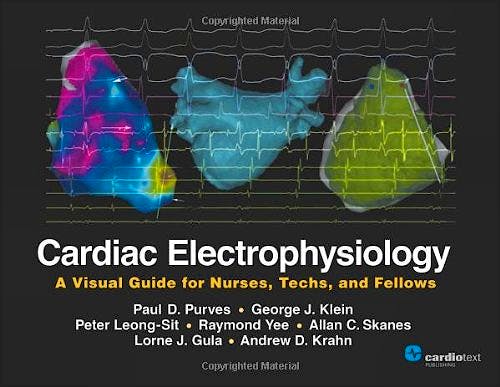

No hay productos en el carrito



Cardiac Electrophysiology: A Visual Guide for Nurses, Techs, and Fellows
Purves
1ª Edición Noviembre 2011
Inglés
Tapa blanda
138 pags
500 gr
null x null x null cm
ISBN 9781935395515
Editorial Cardiotext
LIBRO IMPRESO
-5%
104,40 €99,18 €IVA incluido
100,38 €95,37 €IVA no incluido
Recíbelo en un plazo de
2 - 3 semanas
Description
Cardiac Electrophysiology: A Visual Guide for Nurses, Techs, and Fellows fulfills the need of allied health personnel and new fellows for a practical, hands-on pictorial guide that clearly illustrates the essential concepts of clinical cardiac electrophysiology. More than 70 high-quality tracings, diagrams, fluoroscopic images, and electroanatomic maps accompanied by detailed discussions of each image offer a fundamental understanding of cardiac electrophysiology equipment, principles, and procedures:
• Catheter placement, hardware connections, and intracardiac signals
• Normal electrogram sequences associated with sinus rhythm
• Methodologies used to uncover the mechanisms of common clinical tachycardias
In addition, commentaries provided throughout the book introduce more advanced principles for readers who want to delve further into the EP study.
Authored by a team of experts, Cardiac Electrophysiology: A Visual Guide for Nurses, Techs, and Fellows is an invaluable resource for a complex technology, providing superb guidance in acclimating new trainees and personnel to the EP laboratory and empowering them with the knowledge and skills needed to practice clinical electrophysiology.
Contents
About the Authors
Foreword
Preface
Acknowledgments
Abbreviations
Glossary
Before We Begin an SVT Study
Unit 1: The Basics
1. Catheter Placement
2. The Computer System
3. Signal Processing
4. Signal Sequence in Sinus Rhythm
5. Basic Conduction Intervals
6. Tissue Conduction
7. Supraventricular Tachycardia Diagnostic Study
- Incremental Ventricular Pacing
- Retrograde Wenckebach
- Ventricular Extra-stimulus Pacing
- Retrograde V-A Block
- Ventricular Effective Refractory Period
- Atrial Extra-stimulus Pacing
- Atrioventricular Block
- Atrial Effective Refractory Period
- Incremental Atrial Pacing
Unit 2: Common Clinical Tachycardias
8. AV Nodal Reentrant Tachycardia
- Typical AVNRT Pathways
- Jump
- AV Nodal Echo
- Onset of Tachycardia
9. Atrioventricular Reentrant Tachycardia
- Wolff-Parkinson-White
- Accessory Pathway Locations
- Accessory Pathway Echo
- AVRT Initiation
- Effective Refractory Period of an Accessory Pathway
- Ablation of Accessory Pathways
10. Focal Atrial Tachycardia
11. Atrial Flutter
- Typical Catheter Placement
- Cavo-tricuspid Isthmus Ablation
- Split A’s
12. Atrial Fibrillation
- Basic Diagnosis
- Near-Field Versus Far-Field Electrograms
- Entrance Block
- Exit Block
- Pulmonary Vein Fibrillation
- Independent Pulmonary Vein Activity
13. Ventricular Tachycardia
- Basic Diagnosis
- Activation Mapping
- Pace Mapping
- Entrainment Mapping
- Scar-dependent Ventricular Tachycardia
- Voltage Mapping
- Substrate Modification
Unit 3: Advanced Concepts
14. Mechanisms of Tachycardia
15. Bipolar Versus Unipolar Electrograms
16. Latency
17. Gap Phenomenon
18. PVCs into AVNRT
19. PVCs into AVRT
20. Entrainment Pacing
21. Para-Hisian Pacing
Unit 4: Advanced Tracings
22. An Irregular Rhythm
23. Why Does the A-H Interval Vary?
24.Distinguishing A from V
25. An Unexpected QRS
26. Unusual Onset of Tachycardia
27. Diagnostic Dilemma
28. A Dangling Potential
29. After Pulmonary Vein Ablation
© 2025 Axón Librería S.L.
2.149.0